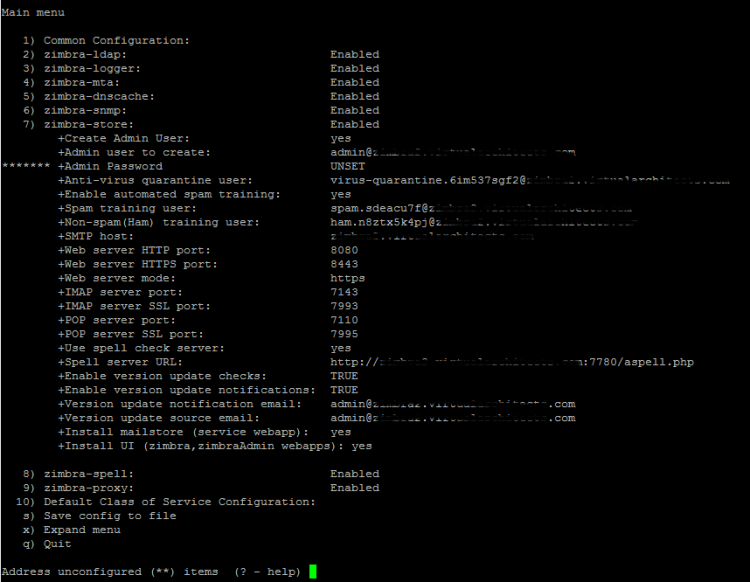User Tools
internet:mail:zimbra:zimbra9
This is an old revision of the document!
Table of Contents
Zimbra 9 OSE
See also Static IP Address
See also Turn Off Snap
See also Using LetsEncrypt SSL Certificates with Zimbra
See also Zimbra with Zextras Add-On
See also Zimbra Migration
Prerequisites
- Install Ubuntu 20.04 Server
- 16GB RAM
- 50GB+ System Disk (/)
- 30GB Temp Disk (/tmp)
- Can be omitted with a much larger System Disk
- 500GB Store Disk (/opt/zimbra/store)
- Sized to your needs
- Update the OS and install some packages
- Configure static public IP address
- Configure external (and internal if split) DNS
- You can leave the MX record until later but the install is 'cleaner' if you do it now
- Configure
/etc/hostsfile- Comment or remove the
127.0.1.1 <shortname>reference - Add a
<ipaddr> <fqdn> <shortname>reference
- Set timezone
- Disable
systemd-resolvedservice- remove the leftover symlink
- Configure new
/etc/resolv.conf - Remove snap
- Install hypervisor tools
- Update the system
- Reboot
apt install openssh-server net-tools wget perl dnsutils timedatectl set-timezone America/Phoenix systemctl disable systemd-resolved.service && systemctl stop systemd-resolved.service rm -rf /etc/resolv.conf sed -i 's/#DNSStubListener=yes/DNSStubListener=no/g' /etc/systemd/resolved.conf cat << EOF > /etc/resolv.conf domain yourdomain.tld search yourdomain.tld nameserver 8.8.8.8 nameserver 1.1.1.1 EOF snap list snap remove snap-store lxd core18 core20 snap remove snapd umount /snap/core/* umount /var/snap apt purge snapd rm -rf ~/snap /snap /var/snap /var/lib/snapd
Install Zimbra 9 OSE
Zextras OSE: https://www.zextras.com/zextras-build-based-on-zimbra-official-repository
First Steps: https://www.zextras.com/thankyou-zextras-build-zimbra/
Requirements: https://www.zimbra.com/documentation/
wget download.zextras.com/zcs-9.0.0_OSE_UBUNTU20_latest-zextras.tgz tar -xzvf zcs-9.0* && cd zcs-9.0* ./install.sh
![]() Hit <enter> to select the defaults for all items, then create the admin password.
Hit <enter> to select the defaults for all items, then create the admin password.
![]() Adjust the domain name to your actual desired e-mail domain name (instead of the hostname).
Adjust the domain name to your actual desired e-mail domain name (instead of the hostname).
![]() You can ignore the MX record error, until you actually want mail to flow properly.
You can ignore the MX record error, until you actually want mail to flow properly.
Services
systemctl status zimbra.service
su - zimbra zmcontrol status zmcontrol stop zmcontrol start
SSL Certificate
Zextras
See also Zimbra with Zextras Add-On
Firewall
LFD
Logging
internet/mail/zimbra/zimbra9.1659709196.txt.gz · Last modified: 2022/08/05 08:19 by gcooper


